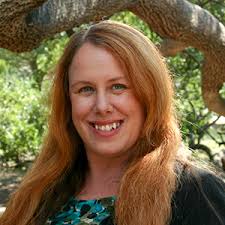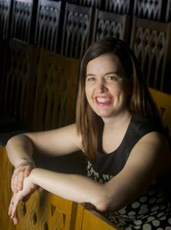Near Washington, D.C., the Rev. Tony Lee sees on Facebook that a church member’s brother has committed suicide -- news he would not otherwise have known -- and is able to reach out to the young man and attend the funeral.
To Lee, it’s a vivid example of how social media gives pastors “longer arms,” providing new ways to stay connected to church members and “touch people who need hope.”
In Seattle, social media is an essential part of the ministry at Quest Church. The congregation’s 25 small groups use Facebook to link members, encourage one another and share information.
“New media helps us more deeply engage in community,” said the Rev. Eugene Cho. “It’s certainly a way for us to build intimacy, … sharing prayer requests and concerns.”
Across the land, in that virtual “place” called the World Wide Web, The Young Clergy Women Project, an online social network of more than 500 clergywomen under 40, is providing young women pastors the support they need to stay in ministry.
Often lacking any nearby female peers, the pastors have found comfort in the online community, which gives them a place to relax and share with others who understand what they are going through.
These three stories are from case studies conducted by the New Media Project at Union Theological Seminary. They are just some of the many places we’re looking to find out how the church is responding in this age of constantly changing technologies.
Established a year ago with funding from Lilly Endowment Inc., the New Media Project seeks to help faith leaders become more theologically savvy about technology.
Although we don’t have all the answers yet -- or even all the questions -- one thing is clear: the widespread use of technology and social media in American culture today is rapidly changing the landscape in which Christian life occurs.
Recommended reading
- Heidi Campbell, associate professor of communication at Texas A&M University and author of “When Religion Meets New Media”
- Elizabeth Drescher, author of “Tweet If You ♥ Jesus”
- Keith Anderson, Lutheran pastor and co-author with Drescher of “Click2Save: The Digital Ministry Bible”
- Kwok Pui Lan, professor of Christian theology and spirituality at the Episcopal Divinity School in Cambridge, Mass.
Our task at the New Media Project is not to justify or be an apologist for technology or for social media giants such as Facebook and Twitter. Rather, we seek to understand this dramatic shift in communication patterns and tools theologically.
If, as Anselm said, theology is “faith seeking understanding,” then our challenge -- our hope -- is to understand what is at stake for the body of Christ during this time.
We hope to recognize new ways of thinking about ourselves, church and God that might be emerging. We want to know: How do our theological assumptions, doctrines, practices, or ways of being and acting in the world as people of faith hold up in this new context?
We began the New Media Project by asking pastors, congregations and leaders in other church-related institutions such as higher education how and why they use social media. Currently, we are surveying younger clergy about their use of social media, because they tend to think differently about technology than their elders.
We have conducted six case studies as a foundation for further theological reflection and maintain an active blog, where our six research fellows and guest specialists contribute regularly. In an effort to live into a social media world marked by creativity and collaboration, we share our research and our thinking as we go, hoping to contribute to the community of conversation now, not just later when conclusions have been reached.
What are we learning?
For one thing, as our survey found, an overwhelming number of younger clergy use social media in their ministries and in their personal lives, and they are generally quite thoughtful about it. They use social media for everything from community building and pastoral care to sermon preparation and event planning. They see social media as the new public square. Since growing numbers of people spend time there, so should they.
Consensus on best ministry practices, however, remains elusive.
Many clergy say it’s important to use social media in ways that emerge “organically” from the culture of a particular community.
As Lee, the pastor of Community of Hope AME Church near Washington, explained, his use of new media must “fit my flow and the flow of the church.” Similarly, the Rev. Eric Elnes, pastor of Countryside Community Church UCC in Omaha, Neb., avoids early adoption of new technology. He wants to ensure that whatever technology he uses makes sense with regular life -- a challenge that becomes easier almost every day.
“The fact of the matter is that as technology matures, it tends to look more and more like our everyday lives,” Elnes wrote on our blog.
Not surprisingly, people differ on what tools are organic to church life, or what the “flow” of a particular pastor might be. For example, the question of how public a pastor should be on Facebook is hotly debated.
On the one hand, Lee and the pastoral staff at Community of Hope use Facebook and Twitter to demystify the life of a pastor, posting news both joyful and mundane.
When Lee met President Obama last year, he used his smartphone to tweet and post photos on Facebook, sharing his excitement with his 2,200-member church. More often, such posts are about routine events -- eating dinner with Mom or going to a concert -- that let members know clergy are not “celebrities,” as one pastor said.
On the other hand, some young clergywomen we interviewed closely guard their private lives online. Developing their pastoral vocation is challenging enough without the openness of Facebook -- and the often-critical public eye that comes with it.
In higher education, many institutions are embracing the rapid changes in communications technology.
At Abilene Christian University in Abilene, Texas, leaders say it is essential to reach students and shape them in the use of new media. They have developed a mobile learning initiative, ACU Connected, and an app, myACU, and equip all faculty and new students with mobile devices such as an iPhone, an iPod Touch or, more recently, an iPad.
John B. Weaver, the school’s dean of library services and educational technology, borrows from Hebrews 12:1 to compare new media -- especially on mobile devices -- to a “digital cloud of witnesses” that is omnipresent in student lives. In both Hebrews and social media, “cloud” is “a metaphor for close proximity and complete envelopment,” Weaver noted on our blog.
Fortunately, it is a cloud that Christian universities can “form and reform through biblical narratives, liberal arts, and Christian practices of confession and profession that are focused not only on the media, but also the messages to which they ‘testify,’” he wrote.
Surprisingly, few writers and scholars are pressing theologically -- beyond some critics’ legitimate concerns about distraction, alienation and addiction -- into the new media world. This absence of theological work may suggest that the church has not yet recognized how significantly the sand is shifting under its feet.
People who did not come of age in the digital world tend to view social media, if at all, as simply a new set of tools that need only to be acquired and mastered.
Once that’s accomplished, they think, they can just put the new tools into play and achieve the same old purpose. More than likely, they will fail. Something bigger is happening in new communication practices, something that skills retraining alone cannot quite capture.
Although the church may be slow to notice social media, the business world is not. Indeed, most articles about social media address the realm of marketing.
Every social media presentation I’ve attended (or conducted) recently has included Erik Qualman’s Socialnomics video, a short film that powerfully demonstrates how rapidly social media has changed the landscape of American -- and global -- life.
The video makes clear that a world altered by social media requires a different way of seeing that world. It is intended for business marketers who are realizing that social relationships drive consumer choices today more than advertisements do. Understandably, they want to learn how to use social media to market their products.
Unfortunately, for them at least, most marketers merely push out the same old message through new channels, without understanding how social relationships function and what they can do. They continue with a one-way communication strategy that has become counterintuitive to active social media users, with the same unimpressive results.
For faith communities, however, social relationships are not foreign. Christians know how social networks work, even if we don’t yet completely understand how they can function online. We’ve been networking ever since Jesus sent out the 70 to carry a message of peace into homes before he arrived.
To Christians, “networking” is better known as evangelism and community building, not marketing. If church people reduce evangelism to marketing as a means simply to increase numbers then they will misunderstand the power of social media and probably get the same poor results as the marketers.
If we define evangelism as transformation -- and understand that relationships are crucial to transformation -- then social media begins to make sense as a powerful tool for extending, as Lee says, “the touch” -- the touch of hope to God’s people.
For now, this new media world is messy.
In many ways, social media level the playing field, flatten the hierarchy. People can access huge amounts of information without requesting permission. They trust what their friends recommend more than what an expert might suggest. And that puts leaders and power structures under tremendous pressure.
The Rev. Gail Bantum at Quest Church confesses there’s “a greater demand for access and a greater expectation of response; … it’s more pressure.” Even those who embrace new media often fight an uphill battle with older generations. The Rev. Nadia Bolz-Weber at House for All Sinners and Saints in Denver, for example, in a post on the New Media Project blog, begs church leaders to “listen to Millennials, please.”
These tensions are bringing to the surface significant theological issues and questions for church leaders. The following are some of the important questions we face -- to which our project will continue to “seek understanding”:
- How do we interpret incarnation and embodiment in relation to online activity?
- What models of the body of Christ are emerging from these new experiences, and what are their underlying theologies?
- Is salvation mediated differently in this new context, and if so, what does that look like and how do we talk about it?
- How do we come to know God and each other today?
- What cautions must we attend to, and what lessons from our history can help us navigate these changes today?
- Do new ways of experiencing each other and the Triune God challenge or undergird what we believe to be true about humanity and the divine?
With varying degrees of comfort and confidence, growing numbers of faith leaders are leaning into new technology. I, for one, am encouraged. If Christian life is to be lived abundantly, we must take seriously the new realities of living in a digitally networked world.














